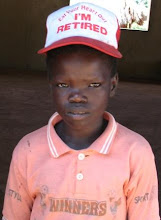Scary Statistics – Southern Sudan[1]
September 2010
Poverty
· 50.6% of the population live on less than 2.5 SDG a day. Poverty is highest in Northern Bahr-el-Ghazal state with 75.6% of the population living below the poverty line.[2]
· 4.3 million vulnerable people will require food assistance in 2010. Of this number, 1.5 million will face severe food insecurity.[3]
Maternal Mortality
· One out of seven women who become pregnant will probably die from pregnancy-related causes.[4]
· 40.6% of mothers do not receive antenatal care at all.[5]
· Only 10.2% of deliveries are attended by skilled birth attendants.
· There are only 13.6% institutional (hospital) deliveries.[6]
· Contraceptive prevalence is only 3.5%.
· There are only an estimated 100 certified midwives.[7]
Child Mortality
· Although the infant mortality rate has decreased, it still stands at 102 per 1,000 live births.
· While the under-five mortality rate has decreased, one out of every 7 children will die before their fifth birthday (135 per 1,000 live births).
Immunisation
· Southern Sudan has one of the lowest routine immunisation coverage rates in the world.
· Only about 10% of children are fully vaccinated.[8]
· Only 28% of children receive measles vaccination before their first birthday.
Malaria
· Malaria is considered hyper-endemic in Southern Sudan, accounting for more than 40% of all health facility visits and 80% of household do not have treated bed nets.[9]
HIV/AIDS
· HIV awareness stands at 45.1%, however only 8% have knowledge about HIV prevention.
· More than 70% of women aged 15-49 have no knowledge about HIV prevention.
Water and Sanitation
· More than 50% of the population do not have access to improved drinking water.
· Only 6.4% of the population have access to improved sanitation facilities.
Primary Education
· Less than 50% of all children receive 5 years of primary school education.
· While 1.3 million children are enrolled, only 1.9% complete primary school education.
· For every 1,000 primary school students there is only one teacher.[10]
· 85% of adults do not know how to read or write.[11]
Gender
· 92% of women cannot read or write.[12]
· Only 27% of girls are attending primary school.[13]
· A 15 year-old girl has a higher chance of dying in childbirth than completing school.
Displacement
Since the beginning of 2010, an estimated 190,000 people have been displaced by inter-ethnic and armed conflicts in Southern Sudan. In 2009, the figure was 391,000 - more than double the number for 2008 which stood at 187,000.[14]
[1] All data unless referenced are from the Sudan Household Survey 2006 t0 2010.
[2] SSCCSE 2010
[3] ANLA Report 2010.
[4] Based on reporting from WHO 2010
[5] WHO Report 2010
[6] WHO Report 2010
[7] MOH Survey 2009
[8] WHO Report 2010
[9] South Sudan MDG Report 2005, UNDP 2006
[10] UNESCO 2009
[11] Alternative Education Systems Unit in the Ministry of Education, UNESCO 2008
[12] Ibid
[13] SSCSE
[14] OCHA EP&R 2010
This is what the anticipated new country of South Sudan is going to have to deal with while also building a nation. Not exactly what you would expect from a country in the year 2011. The challenge of the referendum is only the beginning.
Subscribe to:
Post Comments (Atom)

No comments:
Post a Comment